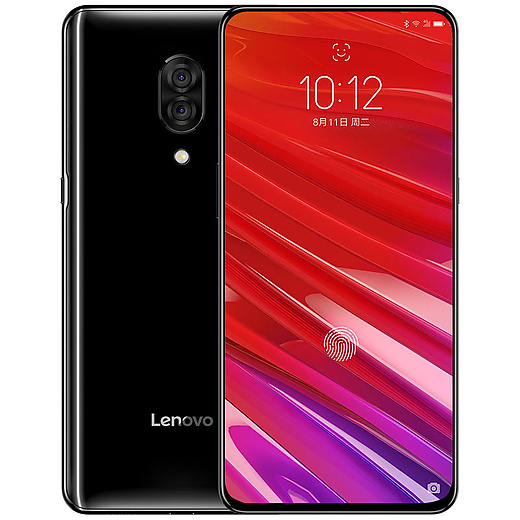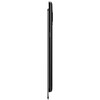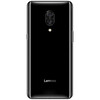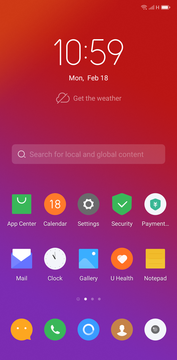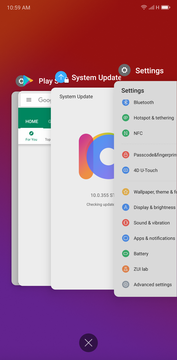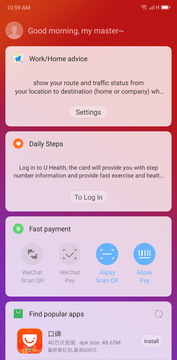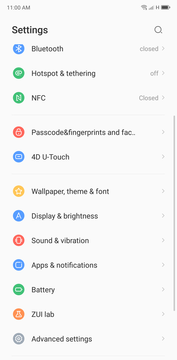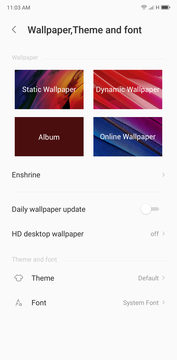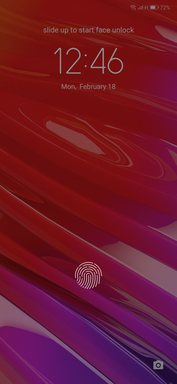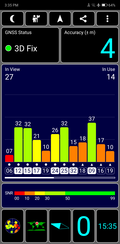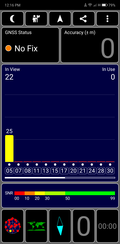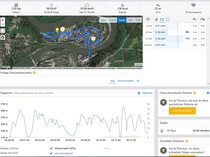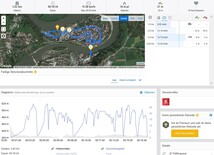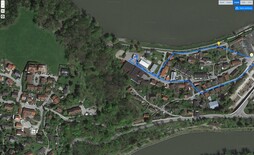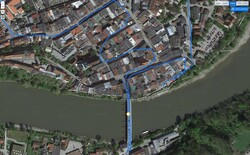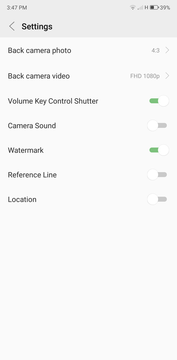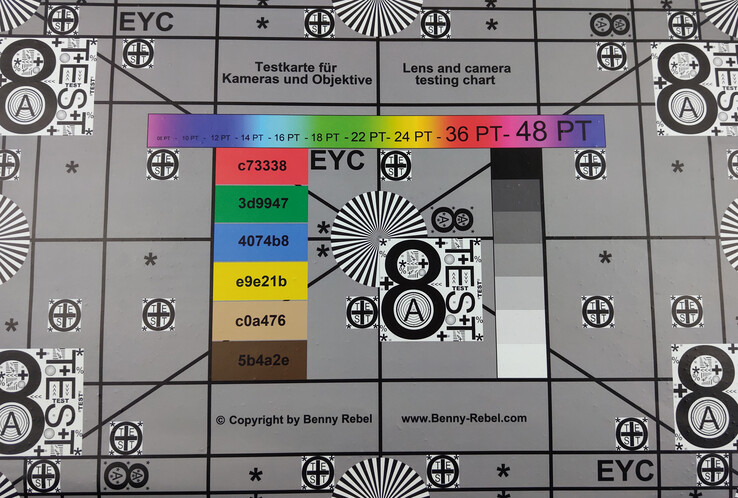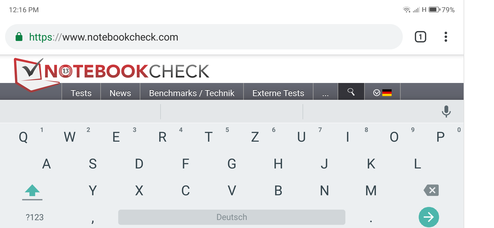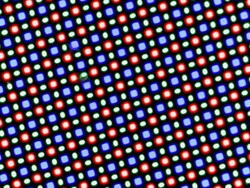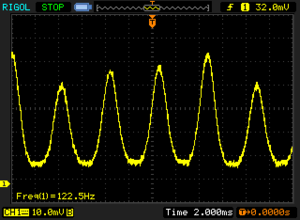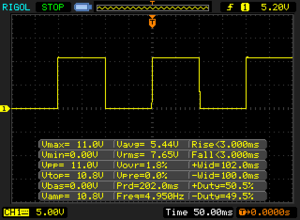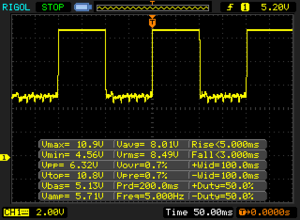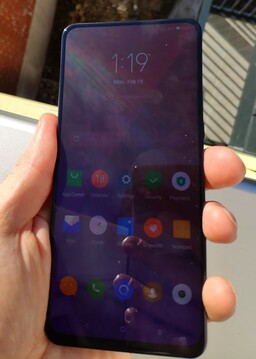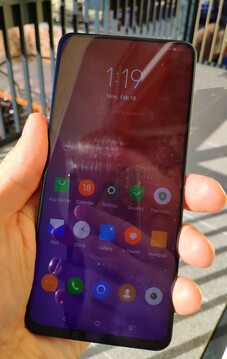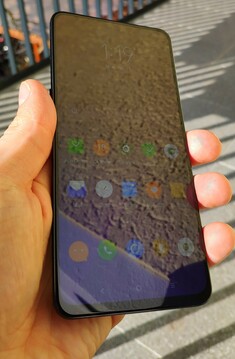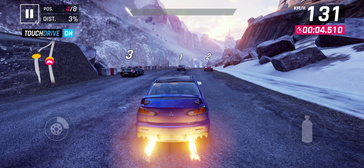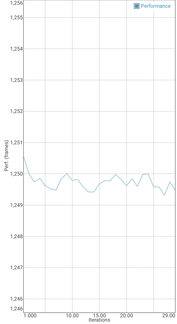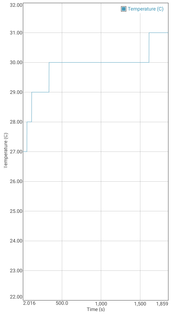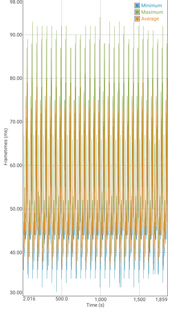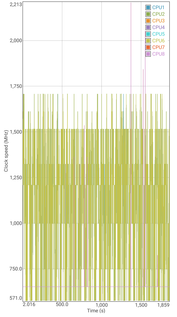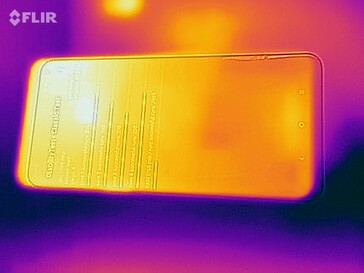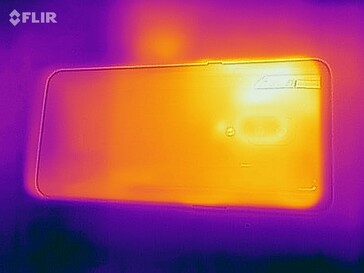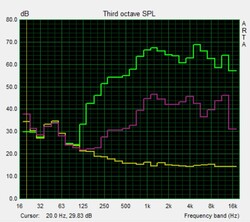Lenovo Z5 Pro Smartphone Review

Unlike its slider-phone competition from Xiaomi and Honor with their flagship Qualcomm processors, the Lenovo Z5 Pro has been equipped with a mid-range SoC: the Snapdragon 710. This allows the Lenovo slider phone to have a slightly more affordable starting price of around $300. Lenovo did not cut any corners in terms of display quality, however.
The organic display in the Z5 Pro has a native resolution of 2340x1080 pixels and a 19.5:9 ratio. The Super AMOLED display is manufactured by Samsung and is 6.39 inches large. Pushing the display down using the slider mechanism reveals a dual selfie camera system with 16 MP and 8 MP as well as infrared sensors for face recognition. The device also has a fingerprint reader, which is integrated beneath the Samsung panel. The back also features two camera lenses in the shape of a dual camera setup.
The Lenovo Z5 Pro can be configured with either 64 or 128 GB of internal storage. The device is currently only available via import companies. The Lenovo phone competes against the other slider phones Xiaomi Mi Mix 3 and Honor Magic 2 as well as current mid-range devices like the Samsung Galaxy A7 (2018) and Xiaomi Pocophone F1.
Case - Z5 Pro with a large display and no notch
Similarly to its slider competition, the weight of the Z5 Pro is quite noticeable: It weighs 210 grams. The advantage of this sliding mechanism is that the front consists almost entirely of the display, which is protected by scratch-resistant 2.5D Corning Gorilla glass.
The bezels around the 6.39-inch OLED panel are very narrow. The same goes for the area below the display. The screen-to-body ratio is 89%.
The Z5 Pro has a better sliding mechanism than that of the Xiaomi Mi Mix 3. The gap between the display and the case is hardly visible, which means that forceful typing will not cause any rattling. There is no sideways play between the body and display.
The volume rocker on the left side and the power button on the right side are easy to reach and sit tightly in the case. The pressure points are very good. We are quite impressed with the workmanship of this device; there is hardly anything to criticize.
Connectivity - no slot for SD card
The internal eMMC storage has a capacity of 64 or 128 GB. The 64-GB version gives the user around 50 GB of free space after initial setup and it is not possible to expand the storage as there is no SD slot. Users can connect peripheral devices such as USB sticks using an OTG adapter for the USB port. This modern Type-C connector positioned at the bottom of the device is also used for recharging the 3350-mAh battery. Data transfer is limited to the 2.0 standard.
The device is also equipped with an in-display fingerprint reader, dual SIM functionality and an LED light for notifications. Users can use Wi-Fi Direct or Miracast for wireless image transmission. DRM-protected content cannot be displayed in HD resolution as the Z5 Pro has an L3 DRM Widevine certification.
Software - Android 8.1 with ZUI
Lenovo has chosen to go with its own user interface ZUI, which is still based on the Google Android Version 8.1. Our test unit runs on the Chinese ROM version, which is not available in German (but does have English). The Android security patches are dated November 2018.
The user interface of the Android OS looks very different to Stock Android. ZUI Version 10 is very colorful and offers a lot of customization options, but it also has a lot of preinstalled bloatware. Installed apps are not collected in an app drawer but are positioned straight onto the various home screens.
As Lenovo is currently not planning on selling this phone outside of China, the ZUI interface does not support Google services such as the Play Store or Gmail ex-works. Instead, it uses Chinese services. However, it is possible to install the Google Play store after purchase.
Communication and GPS - NFC & BT 5.0
Data transmission via the Wi-Fi module is fast thanks to the 802.11a, b, g and ac standards as well as MIMO antenna technology for both the 2.4 and 5-GHz bands. We measured transfer rates of 432 Mb/s and 438 Mb/s between the smartphone and our reference router Linksys EA 8500. This is very good for a smartphone of this price range. Both the range and the signal stability are satisfactory as well.
The communication modules include the current Bluetooth version 5.0 and an NFC chip for near-field communication. This enables users to pay via Google Pay.
Current LTE protocols enable the Lenovo smartphone to load webpages quickly even when using a mobile network. The Z5 Pro uses LTE Cat. 6 (300 Mb/s downstream, 50 Mb/s upstream) to connect to the Internet on the go. However, the included modem does not cover all the necessary LTE frequencies for Germany or the US. The dual SIM smartphone has two slots for a nano SIM card. Both of these slots support LTE speeds, although it is not possible to establish a data connection with both cards simultaneously.
| Networking | |
| iperf3 transmit AX12 | |
| Xiaomi Mi Mix 3 | |
| Xiaomi Poco F1 | |
| Honor Magic 2 | |
| Lenovo Z5 Pro | |
| Samsung Galaxy A7 2018 | |
| iperf3 receive AX12 | |
| Xiaomi Mi Mix 3 | |
| Xiaomi Poco F1 | |
| Honor Magic 2 | |
| Lenovo Z5 Pro | |
| Samsung Galaxy A7 2018 | |
The GPS module of the Z5 Pro easily locates us within four meters outdoors but cannot find a signal indoors.
We tested the accuracy of the GPS module in our mid-range smartphone by letting it run simultaneously with our GPS bicycle navigation system Garmin Edge 520. The Lenovo phone deviated quite strongly with a total difference of 310 meters, which means that the smartphone's GPS module is only moderately accurate. Nonetheless, the device should be suitable for everyday navigation tasks.
Telephone and Voice Quality - display has to be slid down
The voice quality of the included earpiece is pretty good. However, the Z5 Pro can only take and place calls when the sliding mechanism is activated (i.e. the display is pushed down).
Voices are transmitted clearly on both sides and we did not encounter any cuts or reception issues during our test calls using the German Vodafone network.
Cameras - dual cameras on the front and back
The main camera on the back of the Lenovo smartphone has two lenses with an aperture of f/1.8 and an auto focus with phase recognition. While the 16-MP main camera has a 4:3 aspect ratio and 4608x3456 resolution, the second lens has a resolution of 24 MP. Thanks to the second sensor, users can create a bokeh effect by reducing the sharpness of the background. The results are quite decent.
The image quality of the Sony IMX519 sensor is very good for this price range and in good lighting conditions. Both the dynamics and the image details are satisfactory. However, the auto focus has difficulties dealing with fast movements and colors appear rather cool. The Z5 Pro can also take quite bright pictures in low-light surroundings. However, this comes at the price of image noise and low sharpness. Some details are also lost in low lighting.
The pictures of the X-Rite ColorChecker passport show good color accuracy with the 16-MP main camera (no post-editing such as manual adjusting of white balance). White tones appear slightly too warm.
The pictures taken with the 24-MP front camera are of good quality but tend to be overexposed and have a strong soft focus. Due to the slow lens (f/2.2) photos in bad lighting lack brightness. The front camera can also take good-looking portraits with depth of field. Videos are recorded at 1080p and with up to 30 fps. The 16-MP back camera records videos in UHD resolution with up to 30 fps.
Accessories & Warranty - Z5 Pro with Chinese power supply
The device comes with a modular Chinese 18-watt power supply (12 V, 1.5 A) plus USB cable, a SIM tool and an adapter for a 3.5-mm audio jack. Trading Shenzhen also includes an EU adapter that is suitable for sockets in Europe. However, this is not part of the standard scope of delivery.
Lenovo gives a 24-month warranty on its slider smartphone. Please see our Guarantees, Return policies and Warranties FAQ for country-specific information.
Input Devices & Handling - in-display fingerprint reader
Apart from the preinstalled Chinese keyboard, users can also use other keyboards from the Play Store such as Google's Gboard for on-screen input. The multi-touch display responds precisely to inputs with up to 10 fingers and is easy to glide over.
The fingerprint reader that is integrated into the display of the Lenovo smartphone is positioned well and easily unlocks the slider phone most of the time. Similarly to the Xiaomi Mi 8 Explorer Edition, it is not the fastest reader available - although it seems to respond slightly faster on the Lenovo phone.
The phone also lets you unlock it using face recognition, which works reliably but again isn't particularly fast. The Z5 Pro's Face Unlock function, which works via infrared sensors, is slightly more secure than simple face recognition via the front camera. However, it cannot keep up with the security level that 3D face recognition offers by analyzing several thousand points on the face and creating a depth profile.
Display - Super AMOLED panel
The 6.39-inch OLED display has a resolution of 2340x1080 pixels and is easily sharp enough for everyday use. The pixel density of 400 ppi means that it is almost impossible to see individual pixels.
On an all-white display with the brightness manually set to maximum, the Lenovo smartphone reaches 478 cd/m². The brightness distribution is fairly even at 93%. When light and dark areas are distributed evenly (Average Picture Level: APL-50), the IPS panel reaches up to 451 cd/m².
As organic diodes hardly ever shine at their real maximum brightness, they have to be limited. Lenovo uses pulse-width modulation to control the display brightness. The frequency of this flickering is very low at 123 Hz. We personally did not notice any effects of this PWM. However, it can cause headaches and dizziness among more sensitive users - particularly when the frequencies are very low.
| |||||||||||||||||||||||||
Brightness Distribution: 93 %
Center on Battery: 451 cd/m²
Contrast: ∞:1 (Black: 0 cd/m²)
ΔE ColorChecker Calman: 6.07 | ∀{0.5-29.43 Ø4.78}
ΔE Greyscale Calman: 4.4 | ∀{0.09-98 Ø5}
145.4% sRGB (Calman 2D)
Gamma: 2.236
CCT: 7546 K
| Lenovo Z5 Pro Super AMOLED, 2340x1080, 6.4" | Xiaomi Poco F1 IPS, 2246x1080, 6.2" | Xiaomi Mi Mix 3 OLED, 2340x1080, 6.4" | Honor Magic 2 AMOLED, 2340x1080, 6.4" | Samsung Galaxy A7 2018 Super AMOLED, 2220x1080, 6" | |
|---|---|---|---|---|---|
| Screen | 15% | 45% | 16% | 44% | |
| Brightness middle (cd/m²) | 451 | 489 8% | 599 33% | 594 32% | 570 26% |
| Brightness (cd/m²) | 457 | 486 6% | 593 30% | 539 18% | 565 24% |
| Brightness Distribution (%) | 93 | 93 0% | 96 3% | 85 -9% | 93 0% |
| Black Level * (cd/m²) | 0.34 | ||||
| Colorchecker dE 2000 * | 6.07 | 3.8 37% | 1.4 77% | 5.37 12% | 1.5 75% |
| Colorchecker dE 2000 max. * | 11.34 | 7.1 37% | 3.2 72% | 8.32 27% | 3.6 68% |
| Greyscale dE 2000 * | 4.4 | 4.4 -0% | 2 55% | 3.7 16% | 1.2 73% |
| Gamma | 2.236 98% | 2.22 99% | 2.25 98% | 2.127 103% | 2.07 106% |
| CCT | 7546 86% | 7213 90% | 6496 100% | 7212 90% | 6504 100% |
| Contrast (:1) | 1438 |
* ... smaller is better
Screen Flickering / PWM (Pulse-Width Modulation)
| Screen flickering / PWM detected | 122.5 Hz | ||
The display backlight flickers at 122.5 Hz (worst case, e.g., utilizing PWM) . The frequency of 122.5 Hz is very low, so the flickering may cause eyestrain and headaches after extended use. In comparison: 53 % of all tested devices do not use PWM to dim the display. If PWM was detected, an average of 8101 (minimum: 5 - maximum: 343500) Hz was measured. | |||
OLED displays automatically have one clear advantage compared to LCDs: Organic panels can display "absolute" black even in a pitch-black room and at maximum brightness, which means its contrast ratio tends towards infinity.
The average DeltaE deviation of the sRGB color space is decent for this price range with 6.1 for colors and 4.4 for grayscales. The ideal range is below 3. The color temperature is slightly too high at 7546 K rather than the ideal 6500K. We also noticed a slight blue cast on the display.
Display Response Times
| ↔ Response Time Black to White | ||
|---|---|---|
| 6 ms ... rise ↗ and fall ↘ combined | ↗ 3 ms rise | |
| ↘ 3 ms fall | ||
| The screen shows very fast response rates in our tests and should be very well suited for fast-paced gaming. In comparison, all tested devices range from 0.1 (minimum) to 240 (maximum) ms. » 17 % of all devices are better. This means that the measured response time is better than the average of all tested devices (20.2 ms). | ||
| ↔ Response Time 50% Grey to 80% Grey | ||
| 8 ms ... rise ↗ and fall ↘ combined | ↗ 5 ms rise | |
| ↘ 3 ms fall | ||
| The screen shows fast response rates in our tests and should be suited for gaming. In comparison, all tested devices range from 0.165 (minimum) to 636 (maximum) ms. » 19 % of all devices are better. This means that the measured response time is better than the average of all tested devices (31.6 ms). | ||
The Z5 Pro does a good job in bright surroundings thanks to its high-contrast OLED display and content is always readable outdoors - at least during winter. The luminosity of 450 cd/m² might not be able to compensate for bright sunshine in summer. The viewing angles are stable enough for the colors to remain accurate even at very wide angles.
Performance - Qualcomm Snapdragon 710 & 6 GB of RAM
The Qualcomm Snapdragon 710 in the Lenovo Z5 Pro is an SoC based on ARM v8, which was presented in May 2018. The processor has eight processing cores that are coupled using big.LITTLE architecture. The two high-performance Cortex A75 cores clock at up to 2.2 GHz while the weaker Cortex A55 cores have a maximum clock rate of 1.7 GHz. The graphics department is taken care of by an Adreno 616.
Except for the Samsung Exynos 7885 in the Galaxy A7 (2018), the Qualcomm chipset (combined with 6 GB of RAM) in our test unit cannot quite keep up with the Android competitors in our comparison field, although it does offer decent results for a mid-range smartphone. The system performance of our Lenovo phone is good in everyday use as well. It allows for smooth navigating within the Android user interface and causes hardly any lags while multi-tasking.
| PCMark for Android | |
| Work performance score (sort by value) | |
| Lenovo Z5 Pro | |
| Xiaomi Poco F1 | |
| Xiaomi Mi Mix 3 | |
| Honor Magic 2 | |
| Samsung Galaxy A7 2018 | |
| Nokia 8.1 | |
| Average Qualcomm Snapdragon 710 (7041 - 9345, n=6) | |
| Work 2.0 performance score (sort by value) | |
| Lenovo Z5 Pro | |
| Xiaomi Poco F1 | |
| Xiaomi Mi Mix 3 | |
| Honor Magic 2 | |
| Samsung Galaxy A7 2018 | |
| Nokia 8.1 | |
| Average Qualcomm Snapdragon 710 (6453 - 7460, n=6) | |
| GFXBench 3.0 | |
| on screen Manhattan Onscreen OGL (sort by value) | |
| Lenovo Z5 Pro | |
| Xiaomi Poco F1 | |
| Xiaomi Mi Mix 3 | |
| Honor Magic 2 | |
| Nokia 8.1 | |
| Average Qualcomm Snapdragon 710 (20 - 40, n=6) | |
| Average of class Smartphone (18 - 166, n=157, last 2 years) | |
| 1920x1080 1080p Manhattan Offscreen (sort by value) | |
| Lenovo Z5 Pro | |
| Xiaomi Poco F1 | |
| Xiaomi Mi Mix 3 | |
| Honor Magic 2 | |
| Nokia 8.1 | |
| Average Qualcomm Snapdragon 710 (32 - 33, n=6) | |
| Average of class Smartphone (12 - 606, n=156, last 2 years) | |
| GFXBench 3.1 | |
| on screen Manhattan ES 3.1 Onscreen (sort by value) | |
| Lenovo Z5 Pro | |
| Xiaomi Poco F1 | |
| Xiaomi Mi Mix 3 | |
| Honor Magic 2 | |
| Nokia 8.1 | |
| Average Qualcomm Snapdragon 710 (19 - 30, n=6) | |
| Average of class Smartphone (11 - 166, n=157, last 2 years) | |
| 1920x1080 Manhattan ES 3.1 Offscreen (sort by value) | |
| Lenovo Z5 Pro | |
| Xiaomi Poco F1 | |
| Xiaomi Mi Mix 3 | |
| Honor Magic 2 | |
| Nokia 8.1 | |
| Average Qualcomm Snapdragon 710 (23 - 23, n=6) | |
| Average of class Smartphone (8.4 - 413, n=156, last 2 years) | |
| Basemark GPU 1.1 | |
| 1920x1080 Vulkan Medium Offscreen (sort by value) | |
| Lenovo Z5 Pro | |
| Xiaomi Poco F1 | |
| Nokia 8.1 | |
| Average Qualcomm Snapdragon 710 (11.4 - 13, n=3) | |
| Vulkan Medium Native (sort by value) | |
| Lenovo Z5 Pro | |
| Xiaomi Poco F1 | |
| Nokia 8.1 | |
| Average Qualcomm Snapdragon 710 (10.1 - 12.1, n=2) | |
| 1920x1080 OpenGL Medium Offscreen (sort by value) | |
| Lenovo Z5 Pro | |
| Xiaomi Poco F1 | |
| Nokia 8.1 | |
| Average Qualcomm Snapdragon 710 (14.3 - 15.5, n=3) | |
| AnTuTu v7 - Total Score (sort by value) | |
| Lenovo Z5 Pro | |
| Xiaomi Poco F1 | |
| Xiaomi Mi Mix 3 | |
| Honor Magic 2 | |
| Samsung Galaxy A7 2018 | |
| Nokia 8.1 | |
| Average Qualcomm Snapdragon 710 (155113 - 169262, n=4) | |
| AnTuTu v6 - Total Score (sort by value) | |
| Lenovo Z5 Pro | |
| Xiaomi Poco F1 | |
| Xiaomi Mi Mix 3 | |
| Honor Magic 2 | |
| Samsung Galaxy A7 2018 | |
| Nokia 8.1 | |
| Average Qualcomm Snapdragon 710 (135848 - 137693, n=3) | |
| VRMark - Amber Room (sort by value) | |
| Lenovo Z5 Pro | |
| Xiaomi Poco F1 | |
| Nokia 8.1 | |
| Average Qualcomm Snapdragon 710 (1681 - 1708, n=3) | |
| Basemark ES 3.1 / Metal - offscreen Overall Score (sort by value) | |
| Lenovo Z5 Pro | |
| Nokia 8.1 | |
| Average Qualcomm Snapdragon 710 (479 - 488, n=3) | |
| Average of class Smartphone (205 - 7731, n=35, last 2 years) | |
The speed of the Chrome browser is very decent. Complex websites load quickly and can be scrolled through smoothly (for the most part).
| JetStream 1.1 - Total Score | |
| Honor Magic 2 (Huawei Browser 9.0.1.331) | |
| Xiaomi Mi Mix 3 (Chrome 70) | |
| Xiaomi Poco F1 (Chrome 68) | |
| Lenovo Z5 Pro (Chrome 72) | |
| Nokia 8.1 (Chrome 71) | |
| Average Qualcomm Snapdragon 710 (50.5 - 66.6, n=6) | |
| Samsung Galaxy A7 2018 (Chrome 70) | |
| Octane V2 - Total Score | |
| Average of class Smartphone (2228 - 121337, n=197, last 2 years) | |
| Honor Magic 2 (Huawei Browser 9.0.1.331) | |
| Xiaomi Mi Mix 3 (Chrome 70) | |
| Xiaomi Poco F1 (Chrome 68) | |
| Nokia 8.1 (Chrome 71) | |
| Lenovo Z5 Pro (Chrome 72) | |
| Average Qualcomm Snapdragon 710 (9771 - 12802, n=6) | |
| Samsung Galaxy A7 2018 (Chrome 70) | |
| Mozilla Kraken 1.1 - Total | |
| Samsung Galaxy A7 2018 (Chrome 70) | |
| Average Qualcomm Snapdragon 710 (3035 - 3800, n=6) | |
| Lenovo Z5 Pro (Chrome 72) | |
| Nokia 8.1 (Chrome 71) | |
| Xiaomi Poco F1 (Chrome 68) | |
| Xiaomi Mi Mix 3 (Chrome 70) | |
| Honor Magic 2 (Huawei Browser 9.0.1.331) | |
| Average of class Smartphone (257 - 28190, n=154, last 2 years) | |
| WebXPRT 3 - Overall | |
| Average of class Smartphone (38 - 380, n=31, last 2 years) | |
| Honor Magic 2 | |
| Xiaomi Mi Mix 3 (Chrome 70) | |
| Nokia 8.1 (Chrome 71) | |
| Lenovo Z5 Pro (Chrome 72) | |
| Average Qualcomm Snapdragon 710 (57 - 72, n=6) | |
| Samsung Galaxy A7 2018 (Chrome 70) | |
| WebXPRT 2015 - Overall | |
| Xiaomi Mi Mix 3 (Chrome 70) | |
| Honor Magic 2 (Huawei Browser 9.0.1.331) | |
| Xiaomi Poco F1 (Chrome 68) | |
| Nokia 8.1 (Chrome 71) | |
| Lenovo Z5 Pro (Chrome 72) | |
| Samsung Galaxy A7 2018 (Chrome 70) | |
| Average Qualcomm Snapdragon 710 (166 - 209, n=6) | |
* ... smaller is better
The storage device in the Z5 Pro does not belong to the fastest available. Lenovo has given its mid-range smartphone an eMMC storage device rather than a more modern UFS flash storage. AndroBench reports particularly slow read rates.
| Lenovo Z5 Pro | Xiaomi Poco F1 | Xiaomi Mi Mix 3 | Honor Magic 2 | Samsung Galaxy A7 2018 | Average 128 GB eMMC Flash | Average of class Smartphone | |
|---|---|---|---|---|---|---|---|
| AndroBench 3-5 | 45% | 62% | 474% | -7% | 78% | 1008% | |
| Sequential Read 256KB (MB/s) | 284.5 | 705 148% | 675 137% | 908 219% | 295.8 4% | 300 ? 5% | 2228 ? 683% |
| Sequential Write 256KB (MB/s) | 190.8 | 155.6 -18% | 206.8 8% | 185 -3% | 104.9 -45% | 195.1 ? 2% | 1852 ? 871% |
| Random Read 4KB (MB/s) | 77.4 | 101 30% | 133.2 72% | 143 85% | 84 9% | 85.9 ? 11% | 296 ? 282% |
| Random Write 4KB (MB/s) | 14.76 | 17.81 21% | 19.54 32% | 250 1594% | 15.45 5% | 58.1 ? 294% | 339 ? 2197% |
| Sequential Read 256KB SDCard (MB/s) | 85.3 ? | 78.2 ? | 78.1 ? | ||||
| Sequential Write 256KB SDCard (MB/s) | 65.6 ? | 64.4 ? | 61.8 ? |
Games - difficulties with demanding games
The Qualcomm Adreno 616 supports all modern APIs such as Vulkan, OpenGL ES 3.2 and DirectX 12. The GPU is manufactured using the 14-nm process and is considered a well-performing smartphone graphics card. Its performance is 30% higher than that of the Adreno 512 in the Snapdragon 660 according to Qualcomm. Therefore, it wouldn't be surprising if the Z5 Pro displayed graphically demanding games smoothly.
We wanted to find out whether this assumption was correct by trying out a few demanding games from the Google Play Store. We measured the frame rates during these sessions with the help of the GameBench app.
Modern and graphically demanding games such as PUBG Mobile cannot really be displayed smoothly by the Lenovo Z5 Pro. Although we measured an average of 27 fps, there are strong drops in the frame rate, which make playing difficult. The racing game Asphalt 9 Legends is displayed with an average of 22 fps at maximum settings. Even reducing the settings does not prevent strong drops in the frame rate.
The sensors in the slider smartphone and the capacitive touchscreen responded perfectly during our test.
Asphalt 9 Legends
PUBG Mobile
Dead Trigger 2
Emissions - no throttling
Temperature
The heat development of the Z5 Pro is quite high at over 44 °C. These are the maximum values on the back of the device. Luckily, the surface temperatures while idling are hardly worth mentioning at up to 28 °C.
The battery test from GFXBench analyzes the temperatures of the Qualcomm SoC under continuous load. This is created by running the demanding Manhattan test (OpenGL ES 3.1) in a loop for 20 times. Both the battery level and the frame rate are recorded.
The Lenovo Z5 Pro hardly throttles at all under intensive load. The GFXBench battery test shows that the frame rate barely drops as the load increases. The fluctuations in the frame rate remain within 1% of the slider phone's maximum performance. This means that it is improbable that users will encounter drops in performance during continuous load in everyday use.
(+) The maximum temperature on the upper side is 37.5 °C / 100 F, compared to the average of 35.2 °C / 95 F, ranging from 21.9 to 247 °C for the class Smartphone.
(±) The bottom heats up to a maximum of 44 °C / 111 F, compared to the average of 34 °C / 93 F
(+) In idle usage, the average temperature for the upper side is 25.3 °C / 78 F, compared to the device average of 32.9 °C / 91 F.
Speaker
The maximum volume of the single speaker at the bottom of the Z5 Pro is limited to 76.6 dB(A). Its sound quality is very good for a device of this price range. Of course, the middle and high frequencies are more present than the bass, but they are very linear, making the overall sound seem balanced. However, there is some distortion at maximum volume.
The Z5 Pro does not offer an audio jack. Sound is outputted via the USB Type-C port.
Lenovo Z5 Pro audio analysis
(±) | speaker loudness is average but good (76.6 dB)
Bass 100 - 315 Hz
(-) | nearly no bass - on average 16.5% lower than median
(±) | linearity of bass is average (11.8% delta to prev. frequency)
Mids 400 - 2000 Hz
(±) | higher mids - on average 5.3% higher than median
(+) | mids are linear (4.7% delta to prev. frequency)
Highs 2 - 16 kHz
(+) | balanced highs - only 4.8% away from median
(±) | linearity of highs is average (7.2% delta to prev. frequency)
Overall 100 - 16.000 Hz
(±) | linearity of overall sound is average (25% difference to median)
Compared to same class
» 61% of all tested devices in this class were better, 7% similar, 33% worse
» The best had a delta of 11%, average was 35%, worst was 134%
Compared to all devices tested
» 76% of all tested devices were better, 5% similar, 19% worse
» The best had a delta of 4%, average was 24%, worst was 134%
Xiaomi Mi Mix 3 audio analysis
(+) | speakers can play relatively loud (84.8 dB)
Bass 100 - 315 Hz
(-) | nearly no bass - on average 27.4% lower than median
(±) | linearity of bass is average (10.7% delta to prev. frequency)
Mids 400 - 2000 Hz
(+) | balanced mids - only 3.2% away from median
(+) | mids are linear (4.5% delta to prev. frequency)
Highs 2 - 16 kHz
(±) | higher highs - on average 7.4% higher than median
(+) | highs are linear (4.3% delta to prev. frequency)
Overall 100 - 16.000 Hz
(±) | linearity of overall sound is average (21.7% difference to median)
Compared to same class
» 43% of all tested devices in this class were better, 8% similar, 49% worse
» The best had a delta of 11%, average was 35%, worst was 134%
Compared to all devices tested
» 61% of all tested devices were better, 7% similar, 32% worse
» The best had a delta of 4%, average was 24%, worst was 134%
Battery Runtime - good battery runtime
Power Consumption
The power consumption of the Lenovo Z5 Pro is inconspicuous both while idling and under load. However, the Xiaomi Mi Mix 3 is significantly more energy-efficient - particularly while idling.
| Off / Standby | |
| Idle | |
| Load |
|
Key:
min: | |
| Lenovo Z5 Pro 3350 mAh | Xiaomi Poco F1 4000 mAh | Xiaomi Mi Mix 3 3200 mAh | Honor Magic 2 3400 mAh | Samsung Galaxy A7 2018 3300 mAh | Average Qualcomm Snapdragon 710 | Average of class Smartphone | |
|---|---|---|---|---|---|---|---|
| Power Consumption | -24% | 14% | -9% | -11% | 1% | -41% | |
| Idle Minimum * (Watt) | 0.8 | 0.65 19% | 0.49 39% | 0.6 25% | 0.71 11% | 0.772 ? 3% | 0.842 ? -5% |
| Idle Average * (Watt) | 1.4 | 1.97 -41% | 0.67 52% | 0.9 36% | 1.36 3% | 1.474 ? -5% | 1.439 ? -3% |
| Idle Maximum * (Watt) | 1.9 | 2.01 -6% | 0.87 54% | 1.9 -0% | 1.47 23% | 1.882 ? 1% | 1.624 ? 15% |
| Load Average * (Watt) | 3.7 | 4.29 -16% | 3.64 2% | 6.3 -70% | 5.13 -39% | 3.33 ? 10% | 7.03 ? -90% |
| Load Maximum * (Watt) | 5.1 | 9.05 -77% | 9.04 -77% | 7.05 -38% | 7.89 -55% | 5.2 ? -2% | 11.3 ? -122% |
* ... smaller is better
Battery Runtimes
For the slider phone to keep going even on very long days, the Chinese manufacturer has equipped it with a 3350-mAh battery. Due to the efficient Snapdragon SoC and OLED display, the battery runtimes are very satisfactory. The Z5 Pro lasts over 11 hours during our practical Wi-Fi test with display brightness set to 150 cd/m². This positions it in the center of our comparison table.
| Lenovo Z5 Pro 3350 mAh | Xiaomi Poco F1 4000 mAh | Xiaomi Mi Mix 3 3200 mAh | Honor Magic 2 3400 mAh | Samsung Galaxy A7 2018 3300 mAh | |
|---|---|---|---|---|---|
| Battery runtime | |||||
| WiFi v1.3 (h) | 11.8 | 13.5 14% | 12 2% | 12.9 9% | 10.1 -14% |
Pros
Cons
Verdict - nice mid-range slider with gaming blunder
The Lenovo Z5 Pro is a very interesting smartphone that is available for around $300. The slider mechanism allows the mid-range device to flaunt a look that, until now, has mostly been limited to the smartphone elite: A large display that is almost entirely bezel free. The workmanship and material give the Lenovo phone a high-quality exterior.
Unlike its slider competition from Xiaomi and Honor, the Lenovo Z5 Pro is equipped with a Snapdragon 710. This chip is fast enough for users to hardly notice a difference between these devices in everyday use. Only graphically demanding games might currently have to be avoided on the Z5 Pro. The missing modern storage type might be more of an issue as this has a noticeable negative impact on the time applications need to load. This means there are perceptible differences in speed compared to the Mi Mix 3.
The Z5 Pro introduces the slider mechanism to mid-range smartphones. However, the Chinese manufacturer should put some more work into optimizing its slider phone's software.
At the time of writing, the Z5 Pro is not directly available in the US. This means that the phone would have to be imported, which entails certain restrictions, such as the missing LTE support, and risks.
Lenovo Z5 Pro
- 02/26/2019 v6 (old)
Marcus Herbrich




